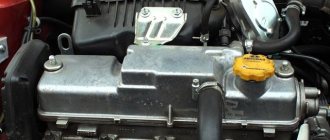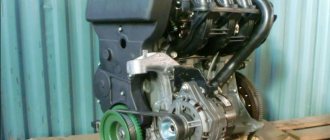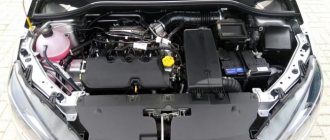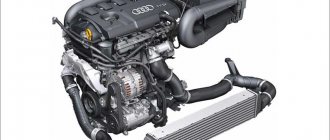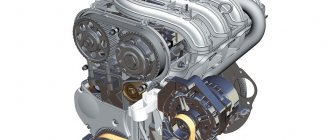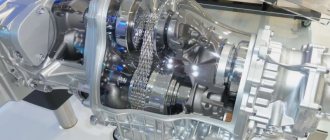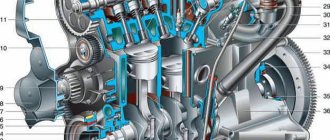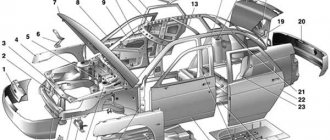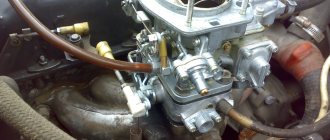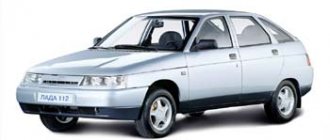Model 2111 (Lada 111) produced by AvtoVAZ is a logical continuation of the 2110 sedan. This is a five-seat front-wheel drive station wagon, created primarily for family use and transportation of small loads. Let's look at the technical characteristics of the VAZ 2111, overall dimensions, design and safety level, as well as the pros and cons of the 11th model.
Although the station wagon is no longer produced, there are still many of these cars on the used car market. Therefore, the description of the characteristics of the eleventh Lada is still relevant. The modification and characteristics of the car also depend on the year of manufacture of the Lada.
Appearance
The design of the car was borrowed from the “ten”. Essentially, this is the same VAZ-2110, only with a larger trunk and roof rails. The car has an identical shape of the front end, fenders and doors.
Many spare parts for the station wagon are suitable from “tens”. This is a big plus, which is noted by owner reviews. The VAZ-2111, depending on the configuration, was equipped with stamped or cast wheels of 14 diameter. Basic versions could also be distinguished by the plugs on the foglights. Otherwise there are no differences. Like the “ten”, branded mirrors with a bluish anti-reflective coating were used here. But motorists have different opinions about the VAZ-2111. Many people criticize these mirrors because they are uninformative and install regular ones from disassembly. In practice, some objects actually disappear in them. But this anti-reflective coating only works at night, and even then only slightly.
Creation of the “tenth” family
AvtoVAZ began preparing a new generation of front-wheel drive cars (base model VAZ-2110) in the mid-eighties. The main objective of producing cars in this series was to replace the company's classic model range. In order to speed up design work, the entire model range of the family was simultaneously constructed, which consisted of the following representatives:
- sedan;
- station wagon;
- hatchback (five-door);
- hatchback (three-door).
Despite this organization of work, the period of crisis did not allow the emergence of new models to be accelerated, and mass production began in 1996. Initially it was the VAZ-2110 sedan, then the production of a station wagon under the symbol 2111 (VAZ-11) and a five-door hatchback 2112 (VAZ-12) began. For foreign buyers, cars received the following designation options:
- LADA-110;
- LADA-111;
- LADA-112.
The cars immediately gained popularity among buyers, primarily due to their affordable cost, individual appearance and comfort previously unavailable for domestic small cars. Production of the sedan continued until 2010; production of VAZ-11 and 12 cars ceased in 2011. It should be noted that the three-door hatchback VAZ-2123 was manufactured from 2002 to 2009.
VAZ-2111 - photo and interior review
The wagon's interior is no different from the 2110 sedan. It has the same solid, angular dashboard with a thin, two-spoke steering wheel. The center console is slightly turned towards the driver. It contains two deflectors, a heater control unit (in expensive versions the car is equipped with air conditioning), as well as a door opening indicator. Below there is a niche for all kinds of little things. The glove compartment on the passenger side is very flat and does not lock.
The main complaints from owners concern the build quality of the interior. The plastic is very hard and begins to disintegrate over time. This is especially true for the center console. After 3-4 years of operation, it begins to crunch and play. This problem is difficult to solve even with additional sound insulation. The steering wheel has an uncomfortable grip, as noted by reviews from VAZ-2111 owners. There is no analogue to it, and the only one available on the market is the Chinese “ProSport”, which is even worse in quality than the factory one.
The seats are very hard - this is evidenced by reviews from VAZ-2111 owners. And although the station wagon is designed for five people, only four can fit normally. There is very little free space in the back. The problem of lack of luggage compartment volume in a station wagon has been solved. Unlike the sedan, which has a capacity of 450 liters, the station wagon can hold up to 775.
Appearance
The design of the VAZ-2111, although inferior in its execution to similar foreign models, was quite interesting and memorable. The company’s designers managed to create this appearance through the use of the following solutions:
- the rapid slope of the hood and windshield;
- wide, almost rectangular head optics design;
- stepped massive front bumper;
- frontal stamping from the front wings to the rear of the car;
- top rails;
- high roof line;
- large side windows;
- slight tilt of the tailgate;
- interesting design of wheel rims;
- top spoiler with built-in additional brake light;
- powerful rear combination lights connected to each other by a plastic insert;
- extended tailgate.
All these decisions formed the image of a large, reliable, universal car for family trips, and also capable of transporting large cargo if necessary.
Specifications
Various power plants were installed on this car. The weakest in the line is a one and a half liter engine with an 8-valve timing mechanism producing 72 horsepower. It was installed on early versions of the station wagon and featured a carburetor power system.
Next came injection engines with distributed injection. This is a “tenth” unit with a capacity of 1.5 liters and a capacity of 77 horsepower. There are also larger engines in the lineup. Thus, the car was equipped with a 1.6-liter engine with 82 horsepower, which then increased to 89. This was facilitated by the installation of a 16-valve head instead of an 8-valve one. The most powerful in the line is a 93-horsepower gasoline engine with two camshafts. He came to the station wagon from the 12-series hatchback. As for the transmission, all power units were equipped with a non-alternative 5-speed manual transmission.
The acceleration dynamics are almost the same as those of the “ten”. Acceleration to hundreds takes from 12.5 to 14 seconds, depending on the engine. But the car is very sensitive to overloads. This is significantly reflected in its dynamic characteristics.
Fuel consumption for all units is approximately the same. So, in city mode the car spends 9 liters per hundred. On the highway this figure drops to 8-7. For those who want to save even more, it is possible to install gas equipment. The design of the engine of the 11th Lada is quite conducive to this, without global “reflashing”.
Tuning of the internal combustion engine cylinder block, conversion of the 8 valve VAZ-2110 (2112) engine to 16 valve.
Tell me, after reading all the above-mentioned information, are you not inspired by the idea of having a car with 16 internal combustion engine valves? In this case, you will be pleased to know that this kind of modernization is allowed. Of course, this process is thorough and cannot be completed without careful preparation. But the result will really justify itself. If you have any doubts, just read the next few paragraphs of the text.
Without going into technical details, the essence of tuning is to replace the cylinder head with a new one. Of course, now you will have two camshafts, and you will also have to rack your brains over the fastening system, because the diameters of the holes in the 16 valve head do not correspond to those on the 8 valve head.
The mounting holes of the block head should be drilled, increasing the diameter from 10 to 12 millimeters.
You can do this yourself, but it is better to contact a specialized workshop. For this kind of work they should not charge more than 3-4 hundred rubles. It should also be taken into account that the standard mounting bolt for the 16-valve cylinder block is slightly smaller than that for the “eight” and must be shortened accordingly.
It is better to study in advance what a 16-valve engine is like on a VAZ 2110 and then you will certainly be able to carry out this kind of tuning yourself. It will be necessary to change the timing belt, pump pump, rollers, wiring, spark plugs, connecting rod mechanism and other structural elements due to the peculiarity of the cylinder head. The head is assembled separately before installation on the engine. After completing the work, it is also advisable to use specialized services for setting up and calibrating the operation of the internal combustion engine.
Underwater rocks
Let's look at what owners' reviews say about the VAZ-2111 car. The advantages of this car mainly concern the trunk. As for problems during operation, they begin after 50 thousand kilometers. First of all, the cooling system makes itself felt. Over time, the pipes leak. The expansion tank cap stops working and does not relieve pressure in the system. As a result, the tank simply bursts.
The clutch disc has a resource of 120 thousand kilometers. But the release bearing wears out by 75. If you repair the clutch assembly, then completely change all the elements. These are the disc, basket and releaser. At 175 thousand, the seals on the gearbox break. The transmission itself, unlike the “nines”, does not require rocker adjustment and does not rattle over time. At 200 thousand, the anthers of the outer CV joint burst. They need to be changed together with the clamps (be sure to use a specialized lubricant for the hinges).
Sport
The rally factory Lada 112 Super1600 class
Lada 21106 2.0 l participated in the 2008 FIA WTCC international championship, where it was used by the Russian Bears Motorsport team, car No. 27 Ladygin Kirill[26], No. 28 Viktor Shapovalov and No. 29 Jaap van Lagen[27]. Since 2009, the team has acquired factory status. In 2010, the Lada Sport team stopped participating in the WTCC. In a VAZ 21103, as part of the LUKOIL Racing Team, the Italian Alberto Scilla won the Russian circuit racing championship in the Supertourism class in 2001 and 2002, and in 2003, Alexey Dudukalo.
From 2004 to 2006, a modification of the VAZ 21106 - 27 took part in the RTCC as part of the Lada Racing factory team. The team's pilots were Alexey Gruzdev (No. 79) and Sergey Nuzhdin (No. 80).
From 2001 to 2003, the VAZ 21124-27 modification participated in the Russian Championship in automobile-circuit racing in the “Supertourism” class; also in 2003, modification 2112-37 became the main car of the circuit monoclass of the National Racing Series “Lada Cup”. Since 2004, a permanent participant in the National class and the Russian RTCC racing series.
Since 1999, VAZ-21106 has participated in the Russian Circuit Racing Championship in the Line 2000 class (Touring), as part of the Motorika Scientific and Technical Center and as part of the AvtoVAZ factory team (except for the 2003 season). from 2004 to 2006 in RTCC on modification 21106 - 27
Based on modification 21106, a racing version of the VAZ-21106-27 car was produced, which later became the VAZ-21107, and the Lada WTCC was also built. Since 2008, participant of the WTCC racing series.
Exhaust
The VAZ-2111 is equipped with a catalytic converter, which becomes clogged at 100 thousand. Naturally, no one is replacing it. The catalyst is cut out and a blende is installed. On engines with an ECU, additional firmware is done so that fuel consumption does not increase.
The muffler begins to rust after 2-3 years of operation. It is aluminized, but this coating quickly peels off the metal. The exhaust manifold and “pants” take a very long time to take care of.
About corrosion
The body is very afraid of rust. It appears within 3-4 years. Reviews from VAZ-2111 owners note that if it is not removed in time with the converter, corrosion will quickly spread throughout the entire body. To extend its life, anti-corrosion treatment should be done regularly.
Problem areas of the body are the sills and rear arches. In order to protect the latter, many install fender liners. But it is strictly forbidden to mount them on self-tapping screws - this will further accelerate the corrosion process. If you regularly treat the arches with Movil and anti-gravel, you can do without fender liners altogether.
Some of the modifications of the “eleventh” differ in their sizes
Naturally, the VAZ-211 is considered by potential buyers as a passenger truck. The station wagon body allows you to “take on board”, including bulky cargo, which is simply impossible to stuff into a sedan, and can hardly be placed in a hatchback. However, sometimes potential buyers are interested in all the dimensions of the car - size can matter, for example, if you have a non-standard garage. So, let's look at the main characteristics of the “eleventh”. In particular:
- length - for almost all modifications it is 4,285 millimeters. The only exception here is the VAZ-2111 “Tarzan” with 1.7 and 1.8 liter engines. They are slightly shorter - 4,255 millimeters;
- the total width, including mirrors, is 1,680 millimeters for almost all modifications. "Tarzans" is also different here. They are slightly wider than the others - 1,710 millimeters;
- height – the situation is exactly the same here. For almost all modifications this parameter is 1,480 millimeters. “Tarzans” stands out here too. They are taller - 1,610 millimeters.
Source
